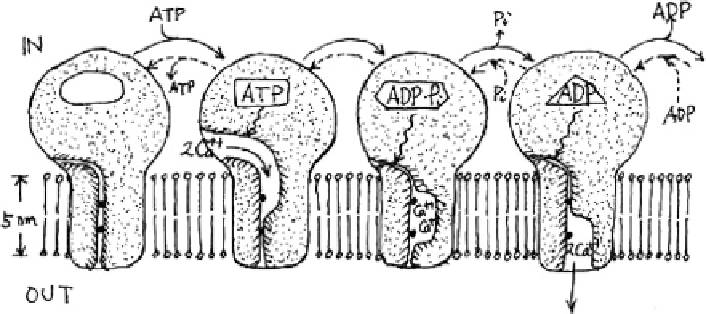Biology Reference
In-Depth Information
Fig. 8.6
A proposed mechanism of the action of the Ca
++
pump based on the conformon theory of
molecular machines (Ji 1974b, 1979, 2000). The model assumes that the pump molecule can be
divided into two domains — the catalytic or
C
(also called
E
1
) domain (see the upper portion of the
pump molecule) and the transport or
T
(also called
E
2
) domain (see the channel in the lower
portion of the pump). Both the
C
and
T
domains undergo coordinated conformational changes
amidst thermal fluctuations as schematized in the form of the changing shapes of the domains.
Conformons can drive any directional motions (including Ca
++
movement across the membrane)
because they carry both
free energy
(in the form of conformational strains which act as the force
generator) and
genetic information
(associated with the local amino acid sequences entrapping
conformational strains). Conformons are thought to be generated in the
C
domain and “effec-
tively” (i.e., directly or indirectly) transported to the
T
domain as symbolized by the wiggly arrows
connecting the
C
and
T
domains, obeying the generalized Franck-Condon principle or the
pre-fit
mechanisms
as discussed in Sect.
2.2.3
. Molecular mechanisms to generate and transport
conformons in enzymes have been presented Fig.
8.1
and in Ji (1974b, 1979, 2000)
8.5 A Bionetwork Representation of the Mechanisms
of the Ca
++
Ion Pump
The mechanism of the operation of the calcium ion pump proposed in Fig.
8.5
can
be represented using the language of bionetwork as shown in Fig.
8.7
. The two
domains of the Ca
++
) connected
by
~
, which symbolizes the structures that couple these two domains mechanically
(see Figs.
8.6
and
8.7
). Each domain is divided into two compartments separated by
a backward slash, /. The
C
domain has the ATP (or ADP) and Pi-binding sites, and
the
T
domain has two calcium ion-biding sites whose accessibility to, and binding
affinity for, calcium ions obey a set of rules. The pump system is postulated to exist
in four distinct states denoted by
I
through
IV
:
ion pump are represented as
C
(
...
) and
T
(
...
1. In State
I
, both the
C
and
T
domains are close to their ligands.
2. In State
II
, the adenine nucleotide-binding site in
C
is accessible from the
cytoplasmic side and the Ca
++
-binding site in
T
binds Ca
++
with high affinity.

